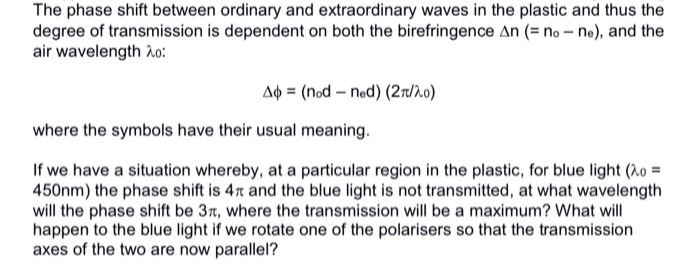The phase shift between ordinary and extraordinary waves in the plastic and thus the degree of transmission is dependent on both the birefringence An (= no-ne), and the air wavelength λo: ΔΦ = (nod - ned) (Σπίλο) where the symbols have their usual meaning. If we have a situation whereby, at a particular region in the plastic, for blue light (o= 450nm) the phase shift is 4x and the blue light is not transmitted, at what wavelength will the phase shift be 3r, where the transmission will be a maximum? What will happen to the blue light if we rotate one of the polarisers so that the transmission axes of the two are now parallel?
The phase shift between ordinary and extraordinary waves in the plastic and thus the degree of transmission is dependent on both the birefringence An (= no-ne), and the air wavelength λo: ΔΦ = (nod - ned) (Σπίλο) where the symbols have their usual meaning. If we have a situation whereby, at a particular region in the plastic, for blue light (o= 450nm) the phase shift is 4x and the blue light is not transmitted, at what wavelength will the phase shift be 3r, where the transmission will be a maximum? What will happen to the blue light if we rotate one of the polarisers so that the transmission axes of the two are now parallel?
Related questions
Question

Transcribed Image Text:The phase shift between ordinary and extraordinary waves in the plastic and thus the
degree of transmission is dependent on both the birefringence An (= no-ne), and the
air wavelength 20:
Ap= (nod-ned) (2π/20)
where the symbols have their usual meaning.
If we have a situation whereby, at a particular region in the plastic, for blue light (20=
450nm) the phase shift is 47 and the blue light is not transmitted, at what wavelength
will the phase shift be 3r, where the transmission will be a maximum? What will
happen to the blue light if we rotate one of the polarisers so that the transmission
axes of the two are now parallel?
Expert Solution
This question has been solved!
Explore an expertly crafted, step-by-step solution for a thorough understanding of key concepts.
Step by step
Solved in 5 steps
